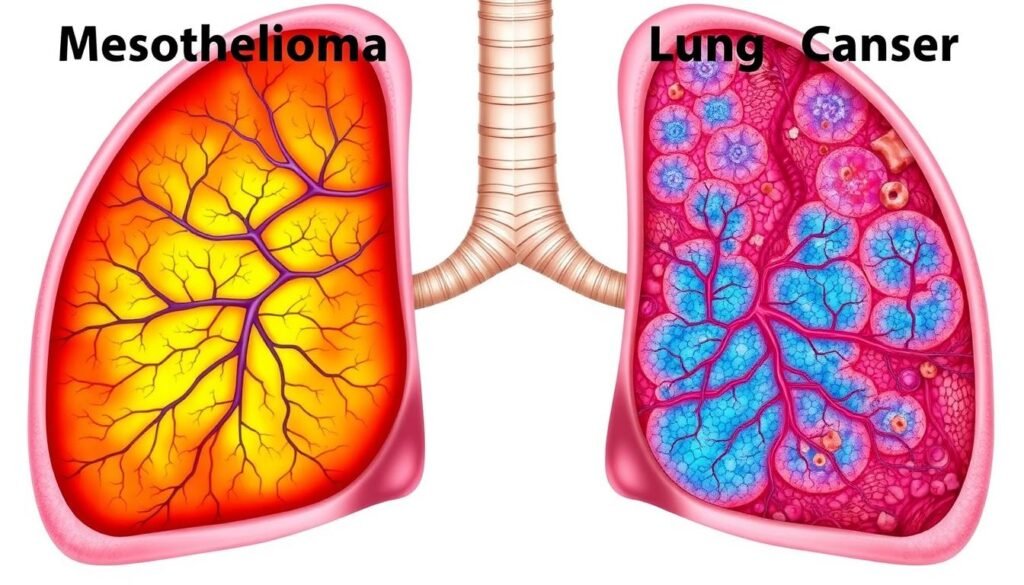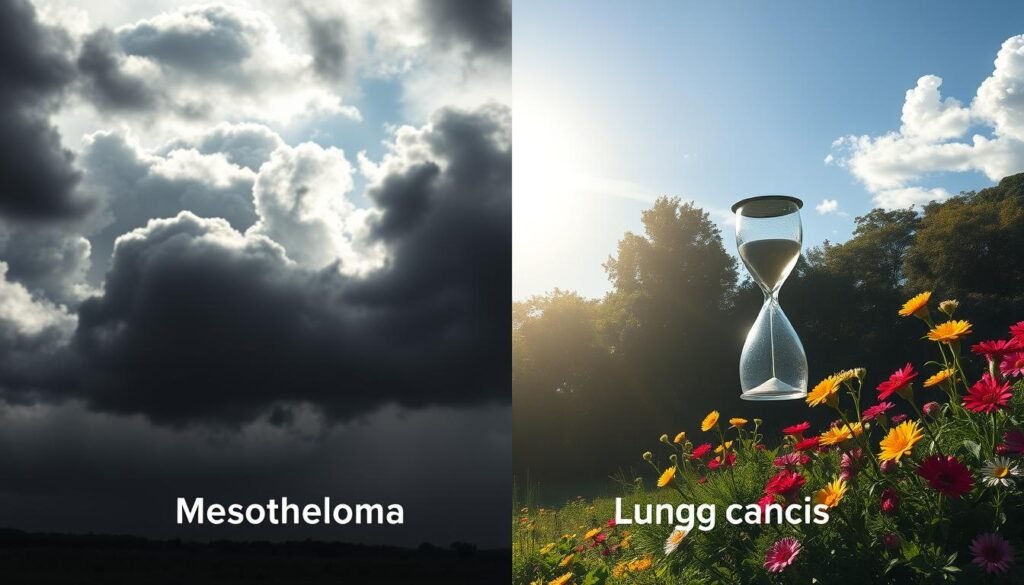Lung cancer is the second most common cancer among adults and is very deadly. It kills more people each year than any other cancer. On the other hand, mesothelioma is rare and aggressive, mainly caused by exposure to asbestos. It affects about 3,000 people each year in the United States. Even though they are different, some think mesothelioma is a kind of lung cancer. This shows we need to be clear about these cancers.
Knowing the difference between these cancers is important. It can help with diagnosis and treatment. Both cancers can be linked to asbestos, making it crucial to understand their nature. Learning about them is key, especially since finding them early can help save lives. In this article, we’ll look at mesothelioma and lung cancer. We’ll see why knowing if mesothelioma is a lung cancer matters.
It’s also important to know symptoms like shoulder blade pain. This symptom can mean there’s a serious problem that needs quick attention. For more on lung cancer symptoms and their link to shoulder pain, check out this resource.
Key Takeaways
- Lung cancer is the most deadly cancer, while mesothelioma is rare but strongly linked to asbestos.
- Only about 3,000 cases of mesothelioma are diagnosed each year in the U.S.
- Early detection for both cancers can greatly improve treatment outcomes.
- Lung cancer is predominantly associated with smoking, while mesothelioma relates to asbestos exposure.
- Understanding the symptoms of both cancer types can aid in early diagnosis.
Understanding Mesothelioma and Lung Cancer
Mesothelioma is a tough cancer that starts in the mesothelium. This is the protective layer around internal organs. The most common type, pleural mesothelioma, mainly attacks the lungs. Lung cancer, on the other hand, grows within lung tissue, often in the airways. It’s important to know the difference between the two, as pointed out in the mesothelioma definition compared to the lung cancer definition.
Lung cancer and mesothelioma both target similar body areas but are distinctly different. Lung cancer leads in U.S. cancer deaths, with 200,000 new cases each year. Pleural mesothelioma is much rarer, with about 2,500 cases a year. Regarding lung cancer, there are two main types: small cell lung cancer (SCLC) and non-small cell lung cancer (NSCLC). NSCLC is more widespread, covering around 80% to 85% of cases.
Knowing the differences in diagnosis and symptoms between these cancers is key. Lung cancer shows up as distinct lumps, while mesothelioma looks like small nodules that can grow into large tumors. Doctors sometimes need extra tests to tell them apart because they share symptoms like coughing and weight loss. Symptoms like shoulder pain could mean something serious and need a quick check. For details, see this helpful article.
Special care is essential for both diseases. Mesothelioma patients usually go to specialized centers for better treatment outcomes. It’s crucial for patients and their families to understand the differences in how these diseases work, how they’re treated, and what risks they bring.
| Cancer Type | Annual Cases | Characteristics |
|---|---|---|
| Lung Cancer | Over 200,000 | Forms distinct masses, aggressive, varies between SCLC (10-15%) and NSCLC (80-85%) |
| Pleural Mesothelioma | Approximately 2,500 | Small nodules that merge into sheath-like tumors, primarily pleural |
Key Differences Between Mesothelioma and Lung Cancer
It’s key to know how mesothelioma and lung cancer differ for proper diagnosis and treatment. Mesothelioma mostly affects the pleura – the lining around the lungs. It can also form in the abdomen and around other organs. On the other hand, lung cancer starts inside the lungs themselves. This main difference shapes the features, symptoms, and possible treatments for each cancer.
Mesothelioma usually starts as tiny nodules and grows into a larger, sheet-like tumor. Lung cancer tumors are different, typically showing up as bigger, single masses. This means the two cancers may respond differently to treatments. For example, surgery might be more beneficial for lung cancer patients in early stages. But mesothelioma is harder to treat with surgery due to its widespread growth.
More than 235,000 new lung cancer cases were reported in the U.S. in 2022, according to the American Cancer Society. Mesothelioma cases were much fewer, with about 3,000 diagnoses per year. This shows why it’s important to understand each cancer’s unique traits for treatment and prognosis. People with mesothelioma generally survive less than 14 months after diagnosis. Lung cancer survival rates are different, depending on the type. For example, non-small cell lung cancer has a 5-year survival rate of about 26%.
| Characteristic | Mesothelioma | Lung Cancer |
|---|---|---|
| Origin | Pleura and other linings | Lungs |
| Common Symptoms | Chest pain, shortness of breath | Chest pain, cough, fatigue |
| Annual Diagnoses in the U.S. | ~3,000 | ~235,000 |
| Median Survival | Less than 14 months | Varies by type |
| 5-Year Survival Rate | ~12% | NSCLC: ~26%, SCLC: ~7% |
What Causes Mesothelioma and Lung Cancer?
Knowing the causes of mesothelioma and lung cancer helps in prevention. Each comes from different causes. This includes unique environmental and biological factors.
Asbestos Exposure and Its Impact
Asbestos is the main reason behind mesothelioma. Many people get sick from being around a lot of asbestos at work. It can take 20 to 50 years for mesothelioma to show up after being around asbestos.
About 80% of those with mesothelioma were exposed to asbestos. Jobs like mechanics, firefighters, and factory workers have a higher risk. Pleural mesothelioma is the most common, seen in over 80% of cases.
For extra info, visit causes of mesothelioma.
Other Risk Factors for Lung Cancer
Lung cancer has several lung cancer risk factors other than asbestos. Smoking is the top cause. Smoking and being around asbestos make lung cancer even more likely. Things like air pollution and radiation also increase this risk.
Knowing these risks helps in fighting mesothelioma and lung cancer. Being aware of asbestos and its dangers is key.
Is Mesothelioma a Type of Lung Cancer?
Mesothelioma and lung cancer seem similar because they both occur near the lungs. But, Mesothelioma lung cancer classification is unique. It starts in the pleural lining, not in the lung tissue. Knowing this difference helps doctors choose the right way to diagnose and treat each one.
About 5% of lung cancers are mesothelioma. It stands out because it usually comes from being around asbestos. People might get sick 30 to 50 years after they’ve been exposed to asbestos. This makes it hard to figure out they have it and to spread awareness.
On the other hand, different lung cancers are not all the same. Small cell lung cancer spreads fast. But, typical carcinoids grow slow and usually stay in the lungs. Knowing this helps doctors teach their patients and pick the best treatment.
The following table shows some of the main differences:
| Aspect | Mesothelioma | Lung Cancer |
|---|---|---|
| Origin | Pleural lining | Lung tissue |
| Causes | Asbestos exposure | Smoking, air pollution, genetic predisposition |
| Growth Rate | Fast-growing | Varies (small cell is fast, others can be slow) |
| Latency Period | 30 to 50 years after exposure | Varies based on type |
| Prognosis | Generally poor, no known cure for many | Varies widely; some can be treated effectively |

Understanding the differences between these cancer definitions is key. It helps patients and doctors make better plans for diagnosing and treating these cancers, leading to better results.
Symptoms of Mesothelioma and Lung Cancer
Knowing the symptoms of mesothelioma and lung cancer is key to early detection. Both have similarities, but also key differences. These differences can help people get the right medical help.
Common Symptoms of Both Cancers
People often show similar symptoms for mesothelioma or lung cancer. These include:
- Chest pain
- Persistent cough
- Shortness of breath
- Weight loss without effort
- Fatigue
This overlap can make it tricky to tell them apart. So, it’s vital to know each condition’s specific signs.
Differentiating Symptoms of Mesothelioma
Mesothelioma has unique symptoms compared to lung cancer. Mesothelioma signs are:
- Pleural effusion (fluid buildup in the chest)
- Pain on the side of the chest or lower back
- Difficulty swallowing and hoarseness
- Swelling in the face and arms
Peritoneal mesothelioma shows different symptoms, like:
- Abdominal pain and swelling
- Nausea and vomiting
- Constipation
Pleural mesothelioma can lead to:
- Chest pain and coughing
- Lumps under the chest skin
Finding mesothelioma symptoms rather than lung cancer signs can change the diagnosis and treatment. It shows why knowing the difference matters.
| Symptom | Mesothelioma | Lung Cancer |
|---|---|---|
| Chest Pain | Yes | Yes |
| Cough | Yes | Yes |
| Shortness of Breath | Yes | Yes |
| Pleural Effusion | Common | No |
| Abdominal Pain | Common (peritoneal mesothelioma) | No |
| History of Asbestos Exposure | Yes | No |
| Weight Loss | Yes | Yes |
Diagnosis Procedures for Mesothelioma and Lung Cancer
Getting the right diagnosis for mesothelioma and lung cancer is crucial. Doctors use many tests to identify these illnesses. These tests confirm if it’s cancer and help decide the best treatment for each person.
Common Diagnostic Tests
Doctors conduct many tests for mesothelioma and lung cancer. They include:
- Chest X-rays
- CT scans
- PET scans
- MRI scans
- Blood tests
Chest X-rays are usually the first step, showing any odd areas. CT scans give a clearer picture, helping to stage the cancer correctly. PET scans show if the cancer has spread. Blood tests look for signs that might point to mesothelioma.
The Role of Biopsies in Diagnosis
Biopsies are key in diagnosing these conditions. They involve taking tissue samples to check for cancer cells. Common biopsy methods include:
- Needle biopsies
- Endoscopic biopsies (thoracoscopy, mediastinoscopy)
- Fluid sample collection through thoracentesis, paracentesis, or pericardiocentesis
These techniques help doctors learn more about the tumor, leading to a clear mesothelioma diagnosis. Biopsies help decide if the issue is mesothelioma or lung cancer, affecting the treatment choice.

Treatment Options for Mesothelioma and Lung Cancer
Both mesothelioma and lung cancer treatments often use surgery, chemotherapy, and radiotherapy. However, mesothelioma’s aggressive nature makes treatment more complex. This results in different effectiveness levels between mesothelioma and lung cancer therapies.
Overview of Treatment Modalities
Before deciding on a treatment plan, doctors look at the cancer’s stage and type. They often recommend:
- Surgery: Useful mostly in early-stage mesothelioma, surgeries like pleurectomy/decortication can help.
- Chemotherapy: Drugs such as pemetrexed work alone or with surgery to boost survival and ease symptoms.
- Radiotherapy: Used after surgery for early-stage cancers or for symptom management in late stages.
- Immunotherapy: This boosts the immune response against cancer, helping in some pleural mesothelioma cases.
Challenges in Treating Mesothelioma
Mesothelioma presents unique challenges in treatment. It’s hard to remove all cancer, and it’s often found late. Surgery might not be an option for some patients because of their health or the tumor’s nature.
Clinical trials are key in finding better mesothelioma treatments. Doctors often suggest them to offer hope and possibly more effective therapies.
In conclusion, treating mesothelioma differs from lung cancer care. It’s important for offering the best support to patients while overcoming treatment challenges.
Mesothelioma Prognosis Compared to Lung Cancer
The outlook for mesothelioma patients is quite different from those with lung cancer. It’s vital for them and their families to know these differences as they look at treatment choices. The survival rates and key factors for both diseases show a clear contrast.
Survival Rates and Statistics
Mesothelioma’s five-year survival rate is about 12%. Lung cancer, however, offers a brighter picture, with early diagnosis pushing survival rates up to 26%. This shows the tough battle mesothelioma patients face compared to lung cancer patients. The stage of cancer when found and the patient’s health play a big role in these numbers.
Lung cancer is the top killer in cancer deaths for both genders in the U.S. In 2013, over 200,000 people were diagnosed, and nearly 160,000 died from it. These numbers stress how key early finding and screening are.
If lung cancer is found early, survival rates jump dramatically. They can go from 25% to 65% for localized tumors. But for mesothelioma, even when found early, the five-year survival rate just goes up to 18%.

Knowing these stats is crucial for those dealing with these diagnoses. Exploring resources on lung cancer survival rates and treatment options is key to understanding what paths can be taken.
| Cancer Type | Annual Diagnoses | 5-Year Survival Rate |
|---|---|---|
| Mesothelioma | 3,000+ | 12% |
| Lung Cancer | 235,760+ | 26% |
Legal Options for Patients with Mesothelioma and Lung Cancer
People with mesothelioma or lung cancer from asbestos have legal paths for compensation. It’s smart to talk to lawyers skilled in asbestos cases. They know how to handle the complicated issues. Victims can seek money for medical bills, lost earnings, and pain. Settlements in asbestos lawsuits often fall between $1 million to $2 million.
There are many types of asbestos lawsuits, including:
- Product liability lawsuits
- Personal injury lawsuits
- Wrongful death lawsuits
- Class-action lawsuits
Each lawsuit type deals with different liability and payment aspects. Victims can get free advice from experienced asbestos attorneys to learn more about their case. To win a mesothelioma or lung cancer case, showing you were exposed to asbestos is key. You’ll need strong evidence, like:
- Proof of employment at an asbestos-using company
- Medical records
- Imaging scans
This evidence connects asbestos to cancer. Asbestos raises lung cancer risk, especially for smokers. Lung cancer usually shows up 15 years after exposure, showing long-term effects.
Choosing a good lawyer is very important. Firms like RPWB are nationally known for their work in asbestos cases. The right legal help can get patients lung cancer compensation, helping them with financial issues from their illness.
| Aspects of Asbestos Lawsuits | Description |
|---|---|
| Types of Lawsuits | Product liability, personal injury, wrongful death, class-action |
| Settlement Amounts | Typically between $1 million and $2 million |
| Evidence Needed | Employment proof, medical records, imaging scans |
| Consultation Cost | Usually free |
Having a lawyer gives patients and families a better shot at getting justice and compensation for mesothelioma and lung cancer.
Conclusion
Understanding the differences between mesothelioma and lung cancer is crucial for the right treatment. Mesothelioma is mainly caused by asbestos and is less common, with about 3,300 new cases a year. In contrast, lung cancer has nearly 200,000 new cases annually. Men are more likely to get mesothelioma, with a high percentage linked to asbestos exposure. This highlights the importance of being aware and taking preventive steps.
Knowing the symptoms, treatment options, and legal support is key for patients. Mesothelioma patients typically have a median survival of one year, while lung cancer patients can live longer. This information is a powerful tool. It encourages working closely with doctors and understanding the risks involved.
Understanding the differences is vital for patients to make informed health decisions. Having the right knowledge helps manage these serious diseases. It ensures patients get the support and resources they need.